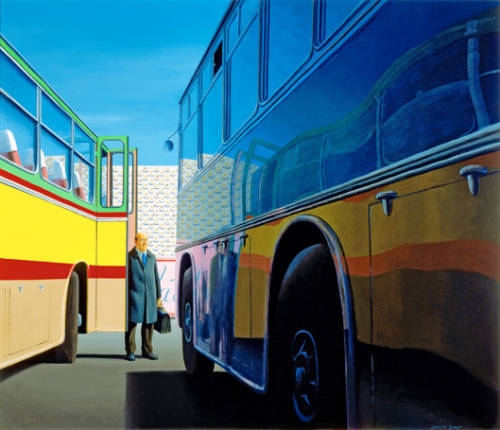Future Beauty: 30 Years of Japanese Fashion. Some amazing fashion pieces and photographs from Japanese designers such as Comme des Garcons, Issey Miyake. I loved Miyake’s dresses that fold up like origami:

And I got in trouble for taking this photo, but I wanted to remember these printed designs:

There was a wonderful exhibition on at QAG called ‘Hanga: Modern Japanese Prints,’ it was exciting to see original prints by Masami Teraoka…

There were also some works by Seiko Kawachi (that look a LOT like Struan’s prints - funnily enough PhD printmaking student George came back from a trip to Brisbane saying the exact same thing) and Yoshio Imamura (text/botanical illustration.)
Hanga: Modern Japanese prints’ features works by some of the leading Japanese printmakers over the past sixty years. These include some of the main proponents of the sosaku-hanga (creative print) movement, Kiyoshi Saito and Kawano Kauro, who developed processes that diverged from the ukiyo-e and later shin-hanga (new print) traditions, as well as artists who found fresh ways to reconfigure traditional imagery and modes of production. Experiments with abstraction and graphic design are also featured, which broadened the established minimalist palette to embrace bold colours and compositions in a range of internationally influenced styles.The beautiful International and Asian collection at QAG included some paintings by Sydney Long and Edouard Vuillard; amazing large-scale paintings by Rim Ho Chol (’On the way to work’ and ‘worker’s home’ - highly illustrative and delicate); and also a few Toulouse-Lautrec originals, and Henri Rivière’s ‘Les Trent-Six Vues de la Tour Eiffel’
‘Sublime: Contemporary Works from the Collection’ was extraordinary, I was particularly excited to have the chance to see Xu Bing’s epic ‘Book from the Sky’:

Sublime: Contemporary works from the Collection’ features artists that create effects of wonder and uncertainty by engaging with sacred architectures, sublime geometries and the power of the natural world.Nearby was this painting, ‘The Traveller,’ by Australian architect-turned-painter Jeffrey Smart:
The exhibition includes large-scale works from the Collection that transform perceptions of space, such as Zilvinas Kempinas’s Columns 2006, Michael Sailstorfer’s Wolken (Clouds) 2010, and the newly acquired HD video installation Raumlichtkunst (Space-Light-Art)

Tracey Moffatt was having a massive exhibition at GOMA, I particularly liked the Pioneer Dreaming series (handmade paper; digital prints hand coloured with ochre)

Continuing with the Japanese theme, there were some incredible works at GOMA in the exhibition ‘We Can Make Another Future: Japanese art after 1989′ With works including Nonhuman Crossing by Sachiko Kazama, some amazing paintings by Tomoko Kashiki (artist website)…


and this sculpture by Takahiro Iwasaki

‘We can make another future: Japanese art after 1989’ surveys the art of Heisei, the current era in the Japanese imperial calendar, through the presentation of around 100 works by over 40 contemporary Japanese artists, drawn from the Queensland Art Gallery Collection. Increasingly cosmopolitan in character and operating with an unprecedented level of international mobility, the art of this period offers a sophisticated reflection on the social conditions behind art’s production in Japan and the anxieties that accompany them.Yayoi Kusama’s obliteration room was the icing on the cake.
‘We can make another future’ draws on the specific composition of the Gallery’s Collection to propose several overlapping frameworks for considering this fascinating period in Japanese history through the art of an extraordinary time. The exhibition explores the emergence of an aesthetic of the digital sublime; responses to the rich field of consumer culture and new technologies of representation and communication; and critiques of national and sexual identity, which through figuration and performance attest to the central role of the human body in contemporary social life.
